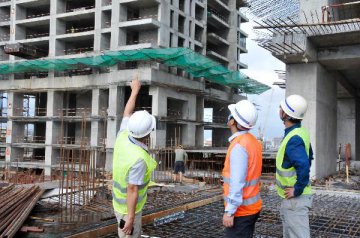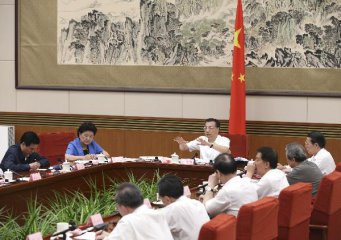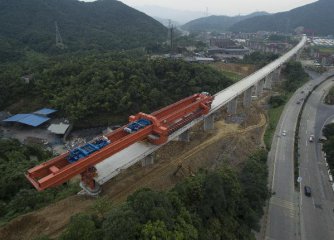 Local governments have successively disclosed their economic performances of in the first half year, including 27 provinces, autonomous regions and municipalities directly under the central government up to now. The GDP growth rate of 21 areas in the first half year outperformed the national figure of 6.7 percent; Chongqing city, Tibet autonomous region and Guizhou province gained a 10 percent growth rate, ranking high nationwide; provinces like Guangdong, Jiangsu and Shandong achieved a total GDP of over 3 trillion yuan, with over 1 trillion yuan for ten provinces including Zhejiang, Hubei and Hebei, according to journalist of Economic Information Daily based on revealed data.
Local governments have successively disclosed their economic performances of in the first half year, including 27 provinces, autonomous regions and municipalities directly under the central government up to now. The GDP growth rate of 21 areas in the first half year outperformed the national figure of 6.7 percent; Chongqing city, Tibet autonomous region and Guizhou province gained a 10 percent growth rate, ranking high nationwide; provinces like Guangdong, Jiangsu and Shandong achieved a total GDP of over 3 trillion yuan, with over 1 trillion yuan for ten provinces including Zhejiang, Hubei and Hebei, according to journalist of Economic Information Daily based on revealed data.The figure of Chongqing declined in the first half year when compared to that of the first quarter this year and the same period last year, but its growth rate of 10.6 percent has still ranked high nationwide for the 10th quarter, and obviously, the investment plays a role of driving the economy. Its fixed assets investment recorded 708,934 million yuan for the first half year, up by 12.5 percent year on year, Zhang Fumin, deputy director general of Chongqing Statistics, indicated. Private investment, in particular, reached 361,974 million yuan, up 9.5 percent, accounting for 51.1 percent of the total investment. Although private investment has constantly declined nationwide since this year, this figure of Chongqing, on the contrary, increased, even setting a new high since Chongqing’s directly under control of the central government, according to analysis.
Some believed that private investment prefers to focus on Chongqing, as its economic transformation brings in development potential larger than other regions. Just on July 26, www.gov.cn issued Written Reply of Approval for Chongqing’s Hi-Tech. Industrial Development Zone to Construct National Self-independent Innovative Demonstration Park of the State Council. Based on information disclosed by Chongqing Municipal Commission of Economy and Information Technology, Chongqing’s industrial structure had constantly optimized in the first half year, with a growth rate of 25.1 percent for hi-tech industrial added value, 14 percentage points higher than the national level. High-end sub-industries supporting the industrial transformation and upgrading, such as intelligent equipment, electronic components, and medical instruments, had achieved a growth rate of over 40 percent for the industrial output value.
Investment is a main drive for economic growth in China, not only in Chongqing. Taking Guizhou for example, its final GDP growth rate was 10.5 percent for the first half year, with 21.5 percent year on year for growth in its fixed assets investment, according to Ren Xiangsheng, head of Guizhou Statistics Bureau. Among three major investment fields, infrastructure gained a growth rate of 21.1 percent year on year for investment, with 16.7 percent for industrial investment. Investment structure continues to adjust, investment strength intensifies for people’s livelihood, and the emerging industries achieve rapid investment growth. Especially, education and health care & social work closely related to people’s livelihood recorded 55.3 percent and 69.3 percent year on year respectively for investment growth.
Sichuan province, with a total economic output of 1 trillion yuan, finally obtained a GDP growth rate of 7.5 percent for the first half year, as its overall investment trend excesses the expectation. Its fixed assets investment was 1,456,210 million yuan, up 12.3 percent and 1 percentage piont year on year, Xiong Jianzhong, chief economist at Sichuan Provincial Bureau of Statistics, introduced. However, weak private investment trend nationwide was also shown in Sichuan. In the first half year, its private investment only increased 5.4 percent, and overall proportion of the total investment even declined to 50.4 percent. Xiong said, domestically, private investment mainly focuses on real estate and manufacturing, and these industries’ profitability weakens in recent years, which causes the said situation. Now, private investment trend is greatly contrasted to that of fixed assets investment in the whole society. It means, state-owned assets investment has to gain a growth rate of over 15 percent, if a whole-year investment wants to maintain a 10 percent growth based on current 5.4 percent one for private investment.
It is worthy to notice that economic growth rate of the Eastern China slowed down in the first half year according to semi-annual economic performances of local governments. For example, Beijing’s economic growth rate of the first half year declined 0.2 percentage point than the first quarter, while this figure was more obvious in Hainan province, with a 1.6 percentage points of fallback. Service industry currently accounts for a large proportion in the eastern regions, but along with industrial transformation and lowering proportion of manufacturing, some traditional industries are shifting to western regions from the east, bringing in rapid industrial growth which also pushes high the GDP growth rate, experts pointed out. But it cannot ignore the investment opportunities introduced by economic transformation for the eastern regions. In the first half year, growth rate of private investment in these regions was obviously better than that nationwide, as private investment always pursues for benefit. The mentioned situation just shows a problem.
Based on GDP growth rate, economic trend differentiation was distinct in regions, that of the Midwest China, including Chongqing and Guizhou, was much faster than coastal regions in the east, Wu Qi, senior researcher at Wanli Chang’an Research Institute, told the journalist. There are two main factors: 1) due to high base number of economy, it is rather difficult for the eastern regions to maintain a high-speed growth, and their industrial economy constantly depress in recent years; 2) supported by the central government’s policies, the Midwest China achieves advantages in risk resources and huge market potentials to quicken the pace for accepting industrial transfer home and abroad, with the development potential and space further released.
“But meanwhile, the pace for economic structural adjustment and industrial transformation & upgrading further speeds up in the eastern regions, and proportion of Hi-tech and modern service industries further enlarge their contribution to the economic growth; based on drive for the GDP growth and weak recover of export & import trade, investment, innovation and consumption have become the main drive to China’s GDP growth”, Wu said.
Translated by Jelly
























Latest comments